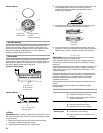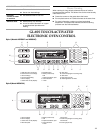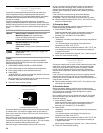
16
Positioning Racks and Bakeware
IMPORTANT: To avoid permanent damage to the porcelain
finish, do not place food or bakeware directly on the oven door or
bottom.
RACKS
■ Position racks before turning on the oven.
■ Do not position racks with bakeware on them.
■ Make sure racks are level.
To move a rack, pull it out to the stop position, raise the front
edge, then lift out. Use the following illustration and charts as a
guide.
Traditional Cooking
*On models with the CleanBake™ feature, foods may be placed
on a lower rack position.
Convection Cooking
BAKEWARE
To cook food evenly, hot air must be able to circulate. For
traditional cooking, allow 2" (5 cm) of space around bakeware
and oven walls. For convection cooking, allow 1" (2.5 cm) of
space around bakeware and oven walls. Use the following chart
as a guide.
Bake
The BAKE function is ideal for baking, roasting or heating foods.
During baking or roasting, the bake burner and broil element will
cycle on and off in intervals to maintain oven temperature.
If the oven door is opened during baking or roasting, the broil
element will turn off immediately and the bake burner will turn off
in 30 seconds to 2 minutes. They will come back on once the
door is closed.
To Bake or Roast:
Before baking and roasting, position racks according to the
“Positioning Racks and Bakeware” section.
For baking, allow the range to preheat before placing food in the
oven. When roasting, it is not necessary to wait for the oven to
preheat before putting food in, unless recommended in the
recipe.
1. Press BAKE once for 350°F (177°C), or press the number
pads to enter the desired temperature.
2. Press START.
“Preheating” will show in the display until the set temperature
is reached.
“Lo” will also appear in the display if the actual oven
temperature is under 170°F (77°C).
When the actual oven temperature reaches 170°F (77°C), the
oven display will show the oven temperature increasing in
1-degree increments.
When the set temperature is reached, if on, 1 tone will sound.
3. Press OFF when finished cooking.
Broil
This range has both a gas burner and an electric halo element
that work together to enhance broiling performance on the broiler
pan and grid provided.
Broiling uses direct radiant heat to cook food. There are 2 broiling
choices: Full Broil and Center Broil. Full Broil uses both the gas
burner and electric halo elements for maximum browning
coverage of foods. Center Broil uses the inner element for
browning coverage of a smaller area.
■ For best results, use a broiler pan and grid. It is designed to
drain juices and help avoid spatter and smoke.
If you would like to purchase a Broiler Pan Kit, it may be
ordered. See “Assistance or Service” section to order.
■ For proper draining, do not cover the grid with foil. The
bottom of the pan may be lined with aluminum foil for easier
cleaning.
■ Trim excess fat to reduce spattering. Slit the remaining fat on
the edges to avoid curling.
■ Pull out oven rack to stop position before turning or removing
food. Use tongs to turn food to avoid the loss of juices. Very
thin cuts of fish, poultry or meat may not need to be turned.
FOOD RACK POSITION*
Large roasts, turkeys, angel food,
bundt cakes, quick breads, pies
1 or 2
Yeast breads, casseroles, meat and
poultry
2
Cookies, biscuits, muffins, cakes 2 or 3
OVEN SETTING NUMBER OF
RACKS USED
RACK
POSITION(S)
Convection Bake 1 1, 2 or 3
Convection Bake 2 1 or 2 and 4
Convection Bake 3 1, 3 and 5
Convection Roast 1 1, 2 or 3
Convection Broil 1 3 or 4
NUMBER
OF PAN(S)
POSITION ON RACK
1 Center of rack.
2 Side by side or slightly staggered.
3 or 4 Placement that gives best result. Make sure that
no bakeware piece is directly over another.
1
2
3
4
5
A.Broil elements
B.Bake element
A
B


















